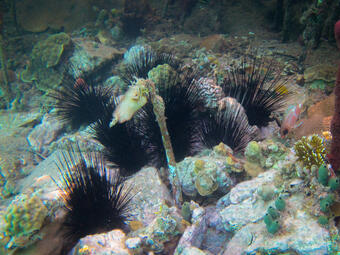Diadema antillarum Mass Mortality
Diadema antillarum scuticociliatosis (DaSc) is an emerging infectious disease affecting sea urchins of the genus Diadema. Caused by a ciliate most closely related to Philaster apodigitiformis, the infection caused mass mortalities of urchins in the Caribbean and Mediterranean Seas in 2022-2023.

Sea urchins in the genus Diadema serve critical ecosystem functions within coral reef environments. As herbivorous grazers, they keep the growth of marine algae in check and prevent it from overgrowing and smothering corals. Globally, at least eight unique species of Diadema are known to exist: D. africanum, D. antillarum, D. clarki, D. mexicanum, D. palmeri, D. paucispinum, D. savignyi, and D. setosum.
The Caribbean species, D. antillarum, was virtually extirpated throughout its native range in the Caribbean Sea and Florida in the 1980s, in what is regarded as one of the worst mass mortality events to ever impact a marine organism. The pathogen responsible for this die-off was never identified, but the long-term implications were severe: this marked the turning point for a transition for Caribbean coral reefs from systems dominated by stony, reef-building corals to reefs dominated by algae and weedier species.
Since the 1980s, D. antillarum population recovery is slow, with active efforts focused on rearing urchins in hatcheries for repopulating the reefs remaining active. Despite limited numbers of D. antillarum on Caribbean reefs, beginning in 2022, another mass mortality event unfortunately struck the remaining populations. Just like in the 1980s, the condition spread rapidly throughout the Caribbean, with affected urchins exhibiting drooping spines, loss of tube foot function, shedding spines, and death. Unlike in the 1980s however, this time the pathogen responsible for the die-off was identified. Scientists from U.S. and international academic institutions, nonprofit organizations, and federal agencies, including the USGS, collaborated to quickly identify a scuticociliate most similar to Philaster apodigitiformis (a single-celled protozoan parasite) as the causative agent of the 2022 die-off, subsequently termed Diadema antillarum scuticociliatosis, or DaSc (Hewson and others, 2023).
In 2023, reports emerged of similar mass mortalities impacting D. setosum urchins in the Mediterranean Sea and the Sea of Oman, with the Oman die-off later confirmed to be due to the same causative agent as the 2022 Caribbean event, indicating that DaSc is spreading rapidly to other regions (Ritchie and others, 2023).
Scientists at the USGS St. Petersburg Coastal and Marine Science Center (SPCMSC), in collaboration with other institutions and agencies, are actively investigating:
- Possible treatments for DaSc
- Transmission mechanisms to explain the global spread of DaSc
- Connections between Philaster apodigitiformis and corals/coral disease
AquaDePTH-Aquatic Disease and Pathogen Repository
Coral Microbial Ecology
Marine Invertebrate Diseases
Testing Treatments Against Parasitic Scuticociliate (Philaster apodigitiformis) that Causes Mass Mortality Among Sea Urchins (Diadema antillarum) - Results Testing Treatments Against Parasitic Scuticociliate (Philaster apodigitiformis) that Causes Mass Mortality Among Sea Urchins (Diadema antillarum) - Results
Evaluation of in vitro treatments against the causative agent of Diadema antillarum scuticociliatosis (DaSc) Evaluation of in vitro treatments against the causative agent of Diadema antillarum scuticociliatosis (DaSc)
Transglobal spread of an ecologically relevant sea urchin parasite Transglobal spread of an ecologically relevant sea urchin parasite
A scuticociliate causes mass mortality of Diadema antillarum in the Caribbean Sea A scuticociliate causes mass mortality of Diadema antillarum in the Caribbean Sea
Diadema antillarum scuticociliatosis (DaSc) is an emerging infectious disease affecting sea urchins of the genus Diadema. Caused by a ciliate most closely related to Philaster apodigitiformis, the infection caused mass mortalities of urchins in the Caribbean and Mediterranean Seas in 2022-2023.

Sea urchins in the genus Diadema serve critical ecosystem functions within coral reef environments. As herbivorous grazers, they keep the growth of marine algae in check and prevent it from overgrowing and smothering corals. Globally, at least eight unique species of Diadema are known to exist: D. africanum, D. antillarum, D. clarki, D. mexicanum, D. palmeri, D. paucispinum, D. savignyi, and D. setosum.
The Caribbean species, D. antillarum, was virtually extirpated throughout its native range in the Caribbean Sea and Florida in the 1980s, in what is regarded as one of the worst mass mortality events to ever impact a marine organism. The pathogen responsible for this die-off was never identified, but the long-term implications were severe: this marked the turning point for a transition for Caribbean coral reefs from systems dominated by stony, reef-building corals to reefs dominated by algae and weedier species.
Since the 1980s, D. antillarum population recovery is slow, with active efforts focused on rearing urchins in hatcheries for repopulating the reefs remaining active. Despite limited numbers of D. antillarum on Caribbean reefs, beginning in 2022, another mass mortality event unfortunately struck the remaining populations. Just like in the 1980s, the condition spread rapidly throughout the Caribbean, with affected urchins exhibiting drooping spines, loss of tube foot function, shedding spines, and death. Unlike in the 1980s however, this time the pathogen responsible for the die-off was identified. Scientists from U.S. and international academic institutions, nonprofit organizations, and federal agencies, including the USGS, collaborated to quickly identify a scuticociliate most similar to Philaster apodigitiformis (a single-celled protozoan parasite) as the causative agent of the 2022 die-off, subsequently termed Diadema antillarum scuticociliatosis, or DaSc (Hewson and others, 2023).
In 2023, reports emerged of similar mass mortalities impacting D. setosum urchins in the Mediterranean Sea and the Sea of Oman, with the Oman die-off later confirmed to be due to the same causative agent as the 2022 Caribbean event, indicating that DaSc is spreading rapidly to other regions (Ritchie and others, 2023).
Scientists at the USGS St. Petersburg Coastal and Marine Science Center (SPCMSC), in collaboration with other institutions and agencies, are actively investigating:
- Possible treatments for DaSc
- Transmission mechanisms to explain the global spread of DaSc
- Connections between Philaster apodigitiformis and corals/coral disease




